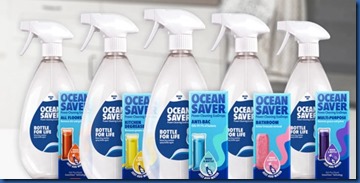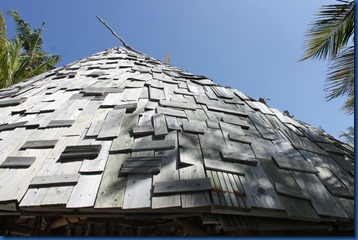The more challenges that climate change throws at the Maldives, the more create innovation it throws right back. The latest approach to coral regeneration is Nova’s depth-adjustable coral nursery. Developed by Nova Marine Biologist, Toby Corren with guidance from Dr. Inga Dehnert during the early stages, the depth of the line with the coral pieces are adjusted by shortening or lengthening the ropes attached to the horizontal propagation ropes which are anchored at the bottom with D-ring anchor points. The main objective of this depth flexibility is to help mitigate stress responses from increased sea surface temperatures in the upper water columns, especially during bleaching events. The project is currently focused on fast-growing scleractinian corals, but they plan to expand the nursery to include a broader range of species in the future.
Is the “Sinking Maldives” the Maldives “Undertoad”?
The Maldives has been a poster child for the devastating impact of climate change. The image of an entire nation sinking into the depths of ocean captures the imagination like the tales of Atlantis. Newsweek recently published an article titled “We Are all Maldivians” which asserted:
- “If the Maldives sinks, it will also be time up for hundreds of millions of people who live in low-lying areas across the world.”
Article co-author former President Mohamed Nasheed is responsible for bringing the “sinking” meme to the world’s attention. It all started with a brilliant publicity stunt of holding a cabinet meeting underwater, and spread with Nasheed’s evangelical global advocacy for climate action.
First of all, let’s dispense with the semantic nicety that the Maldives are not “sinking” in the notion of their altitude getting close to the Earth’s centre. The land level is not dropping to any tectonic subduction, but rather the sea level is rising making the relative elevation above sea-level lower.
Nasheed’s piece cites a paper suggesting a sea-level rise of nearly 19mm per year, but recent data estimates that sea-levels are rising at a rate of 3.6mm per year [Royal Society]. This rise is the result of two main impacts of global warming: (a) melting Arctic land ice (eg. Greenland, Antarctica), and (b) expanding size of water at higher temperatures. The average elevation of the Maldives is 1600mm. So at the current rate of sea level rise, the Maldives won’t be mostly “sunk” for another 400 years. By which time, other problems like global famine and extreme weather events are much more likely to have decimated welfare more than the available land above water.
The ”sinking” calculations also assume that the Maldivians stand around passively and do nothing. They might not be able to unboil the ocean, but they can change the elevation of their country. In fact, despite rising sea levels of recent years, net Maldivian elevation has actually risen. Like the low lying ‘lands of nether” centuries before, Maldives has aggressively pursued efforts of terraforming which basically make islands out of ocean (as opposed to ocean out of islands when they sink) by dredging up landfill from the bottom of the ocean. In recent years, the country added over 432 hectares with the development of Huhumale island, and the president just recently announced the Ras Male project to add another 1,150 hectares (see photo below) with another major project in the Addu atoll aming to add 252 hectares. In the battle between rising seas and rising land, the land is winning.
Let me be clear…I am not denying climate change. The evidence that I have examined extensively does clearly show that (a) climate is changing, (b) this change’s speed is unprecedented in human history (limiting society’s ability to adapt in time), and (c) human activity (especially burning hydrocarbons) is the major contributor. Nor am I denying sea level rise. The oceans are rising and will continue to do so with climate change.
Why such pedantic distinctions? First of all, exacting accuracy matters in issues of science. By glossing over details, the climate activists expose themselves to the climate deniers who point out their minor errors and equate them to undermining all of science’s claims (the rhetorical term is “false equivalence”). Furthermore, people might end up fearing (and fighting) the wrong outcome. With limited political will (and hence public sector budget) to counter climate change, picking the right battles is important.
I am reminded of a passage from the book, “The World According to Garp” that an aquatic destination like the Maldives will appreciate:
- “He stood ankle-deep in the foam from the surf and peered into the waves, without taking a step, for the longest time. The family went down to the water’s edge to have a word with him. ‘What are you doing, Walt?’ Helen asked…’I’m trying to see the Under Toad,’ Walt said. ‘The what? said Garp.’ ‘The Under Toad,’ Walt said, ‘I’m trying to see it. How big is it?’ And Garp and Helen and Duncan held their breath; they realized that all these years Walt had been dreading a giant toad, lurking offshore, waiting to suck him under and drag him out to sea. The terrible Under Toad.”
What are the real “undertows” in the treacherous waters of climate change (as opposed to the “under toad” distractions)?
- Severe weather events – Even flooding in the Maldives is not from daily sea levels encroaching, but instead the result of surges from severe storms (eg. “Study highlights complex causes of Maldives flooding”. Warmer air and water temperatures intensify the concentration of humidity and energy in the atmosphere which create bigger and stronger storms.
- Death of the oceans – The death of ocean is the death of the Maldives since that country is 99.97% ocean. Its two main industries are tourism and fishing. And both depend on the ocean. Tourism first started entirely predicated on the allure of its ocean as a diver’s paradise. Over time, the appeal grew to more of an over water experience with water villas, over-water spas, over-water restaurants, etc. The ecological change in the marine life of the oceans will have a more dramatic effect on the lives of Maldivians more intensely and more immediately than its average elevation.
The aboriginal Maldives was mill-pond calm lagoons with crystal clear waters and teeming with colourful tropical fish darting amongst colourful corals. With warmer waters comes the bleaching and demise of the corals, and the knock-on drop in fish populations. And it’s not just underwater, but over water the increased temperatures bring increased winds frothing up the water and disturbing the sought after tranquility. Land reclamation might counter millimeter level rises in sea level, but not powerful and large ocean surges from increasingly powerful tropical storms. Like Walt’s ocean fear, people are fearing the “under toad” of “sinking” instead of the very real “undertow” of severe weather and dying coral reefs.
[POSTSCRIPT] These points underscored by this article “Nearly 1,000 disappearing islands in Maldives growing in size, surprising experts“:
- “If reports are to go by, when researchers analysed decades of aerial photos and satellite imagery, they came across an intriguing trend: Most islands have remained stable or even increased in area.”
Best of the Maldives: Eco-Cleaning – Amilla
Choice of ingredients and packaging is the first line of attack in saving the environment. The mantra “Reduce, Re-Use, Recycle” is intended in that order or priority. Reducing consumption of the things that harm the environment has the biggest impact in sustaining it. These changes can go all the way to the backroom considerations of the cleaning products a property uses. Amilla Maldives has adopted the appropriately named Ocean Saver for its domestic needs:
- “Just drop one of our plant based, non toxic EcoDrops into an empty bottle filled with tap water and shake! No fuss, no mess and zero plastic waste.”
For a cleaner conscience.
Best of the Maldives: Mosquito Control – Soneva Fushi
The most common response to the question of “which species on the planet would you like to get rid of” is “mosquitos”. The are a very problematic creature transmitting many (sometimes deadly) diseases while very few species depend on eating them. I’ve never experienced many “mossies” during my many stays, but the tropical environments are common breeding grounds for them, visitors sometimes get bothered by them and the country has had reports of dengue fever in the past.
A typical measure is fumigation which some resorts do in the late afternoon and early evening, but this process can be noisy and irritating as well as contain troublesome chemicals. As CNN reports in its article “A paradise island vacation with no mosquito bites – and no chemicals”, Soneva Fushi has introduced an innovative technology to keep the numbers down in the least intrusive and more environmentally friendly way:
- |Soneva first employed the Biogents system in 2019, using two different types of traps – more than 500 in total positioned around the island. The first type, called the BG-GAT, is a passive trap meant for tiger mosquitoes that have already bitten someone and are searching for a place to lay eggs, according to Oines. The second type, the BG-Mosquitaire CO2, is meant to attract mosquitoes searching for blood, which it does by using carbon dioxide created through yeast and sugar fermentation, plus lactic acid, which mimics human skin. Beyond just using the traps, the resort has educated staffers on mosquito ecology. Now, the Soneva team does inspections of the property to identify and reduce things like tarps, fallen coconut shells and anything else that could hold stagnant water, which is necessary for the bugs to breed… The resort said it recorded a dramatic decrease in the island’s mosquito population by upwards of 98% in the first year.
Best of the Maldives: Largest Floating Solar Array – Taj Exotica
The best places in the world for solar are power are those with (a) lots of sunshine, and (b) significant expanses of space to collect those sun rays. While the “Sunny Side of Life” has plenty of the former, this island archipelago has notoriously little of the latter. On land that is. But Taj Exotica has taken advantage of the destination’s largest resource – the ocean – in order to reduce carbon footprint to help save that self-same ocean.
- “The SolarSea system, coupled with a battery storage solution, allows the resort to run entirely on renewable energy during daylight hours. This eco-friendly approach translates to a reduction of approximately 475,000 liters of diesel consumption annually, along with a decrease of 1,200 tons in carbon footprint.”
Best of the Maldives: Water Villa Solar Panels – SO Maldives Patina / Ritz Maldives
The Maldives has long been pioneering sustainability with ambitious use of solar power, and now SO Maldives, The Patine and Ritz Carlton Maldives (thanks Paola) have set a new high water mark over the water installing solar panels on the roofs of every single one of their water villas. Top move.
Best of the Maldives: Recycled Construction – Soneva Jani
Many resorts recycle the small consumables like bottles and packaging, but Soneva Jani has recycled so much of its construction materials that it was able to make an entire restaurant out of them. In fact, the construction design of the “Crab Shack” was also inspired by the story of a local fisherman:
- “For years, the fisherman collection small pieces of driftwood and any other gifts the sea would bring him. Friends who saw his enthusiasm started to collect useful items for him, from wherever they could find them. A discard chair, mismatches plates and cutlery, pieces of driftwood…He didn’t mind that every chair in his restaurant would be different, he actually liked the thrown-together feel of it all.”
Best of the Maldives: Waste Heat Recycling – Six Senses Laamu / Kuramathi
Most of resorts recycle our paper, plastic and metal. Some go further to recycle more esoteric items like construction materials and coconut husks. But Six Senses Laamu and Kuramathi have introduced a recycling not a material, but energy. They have installed waste heat recycling technology:
- “The Kuramathi team initiated a plan to connect large part of the Island to a cutting-edge hot water supply system. What sets this project apart is our innovative approach to using waste heat generated by powerhouse generators. We have harnessed this heat to produce hot water, eliminating the need for traditional electric boilers. This saves not only time but also conserves both water and electricity. As of now, one-third of the Island including 160 villas is connected to the system, with a goal to have the entire Island linked in the future.”
Best of the Maldives: Artificial Thatch – Dhawa Ihuru
One of the classic tick-boxes for a Maldivian resort are the archetypal thatched roof villas. While styling contemporary designs have proliferated across the destination with dramatic aesthetic allure, many still want that ‘authentic’ vibe of a Robinson Crusoe hut on a tropical island. A major challenge to catering for this preference is that palm thatch roofs are very expensive to build and maintain. Dhawa Ihuru has outfitted its buildings with Palmex artificial thatch which not only keeps costs down (do the property can be more affordable), but is also itself an eco-friendly solution being produced in a sustainable way and reducing the demand on harvesting palm trees as Palmex describes:
- Product waste in all our plants is diverted from final disposal and sent to be recycled in other plastic manufacturing processes. Our packaging is kept to an absolute minimum for shipping and is made of Palmex production waste. We have also undergone a third-party verification process with Vertima Inc. and Athena Sustainable Materials Institute where Palmex International Inc. products and our entire supply chain were assessed. We received the Validated Eco-Declaration® Certification summarizing verified environmental claim.
Frankly, we didn’t even notice that they are artificial until it was pointed out to us and we had a look very close
Best of the Maldives: Low Carbon Cocktail – Patina Maldives
Planet wellness is more about low-carbon than low carbs, and The Patina features a range of low carbon concoctions for your Earth-friendly enjoyment:
- “Every cocktail and spirit served at Patina Maldives, including the Fari Beach Club, will eliminate 30 grams of carbon emissions in comparison to drinks crafted at beverage outlets with conventional labels. This is thanks to the world’s first low carbon, low waste spirits distribution technology.”















